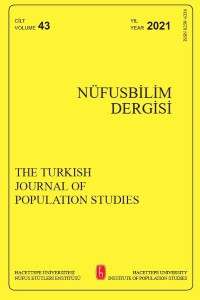SONRADAN TABAKALAMADA ORANSAL TAHMİN EDİCİLER
RATIO ESTIMATORS IN POST-STRATIFICATION
___
- Aksu, E.E., (2009). Post-stratification and an application. TURKSTAT Expertness thesis. Bacanli, S., Kadilar, C. (2008). “Ratio estimators with unequal probability designs”, Pakistan Journal of statistics, 24(3), 167-172.
- Bethlehem, J. G. and Keller, W.J. (1987). “Linear Weighting of Sample Survey Data”, Journal Of Official Statistics 3(2), 141-153.
- Cervantes, I.F. and Brick, J.F. (2009). “Efficacy of Poststratification in Complex Sample Design”, Proceedings of the Survey Research Methods Section, Alexandria, VA: American Statistical Association. 4642-4655.
- Cochran, W.G. (1977). Sampling Techniques. New York; Wiley.
- Hansen, M.H., Hurwitz, W.N., Madow W.G. (1953). Sample Survey Methods and Theory Volume II-Theory. Canada; John Wiley&Sons, Incorporation.
- Holt, D., Smith, T.M.F.(1979). “Post-Stratification” , Journal of the Royal Statistical Society A, 142, 46.
- Kadilar, C., Cingi, H. (2003). “Ratio estimators in stratified random sampling”, Biometrical Journal. (2003)2, 218-225.
- Kim, J.J., Li, J., and Valliant, R. (2007). “Cell Collapsing in Poststratification”, Survey Methodology, , 139-150.
- Rueda, M. M., Gonzalez, S. and Arcos, A. (2006). “A general class of estimators with auxiliary information based on available units”, Applied Mathematics and computation. 175, 131-148.
- Särndal, C.E., Swensson, B., Wretman, J. (2003). Model Assisted Survey Sampling. New York; Springer.
- Singh, S. (2003). Advanced sampling theory with applications. Kluwer, Netherlands
- Sisodia, B. V. S. and Dwivedi, V. K.. (1981). “A Modified ratio estimator using coefficient of variation of auxiliary variable”, Journal of Indian Society Agricultural Statistics. 33, 13–18.
- Upadhyaya, L. N. and Singh, H. P., (1999). “Use of transformed auxiliary variable in estimating the finite population mean”, Biometrical Journal 41, 5, 627–636.
- Zhang, Li-Chun (2000). “ Post-Stratification and Calibration- A Synthesis”, The American Statistician, 54, 178-184.
- ISSN: 0259-6334
- Başlangıç: 1979
- Yayıncı: Hacettepe Üniversitesi
TNSA VERİLERİNDEN SEÇİLMİŞ DEMOGRAFİK GÖSTERGELERİN TEKRAR HESAPLANMASI: TABAKALAMANIN ETKİSİ
Tuğba ADALI, A. Sinan TÜRKYILMAZ
Kadınların Bakış Açısından Kürtaj
Alanur ÇAVLİN, Sabahat TEZCAN, Banu ERGÖÇMEN
Türkiye Nüfusu İçin Stokastik Ölümlülük Modelleri
